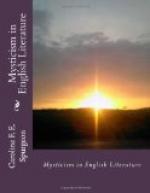Ice-cold seems heaven’s
noble glow
To spirits whose vital heat
is hell.
He insists that Space and Time belong only to physical life, and when men pass into the spiritual world that love is the bond of union, and thought or “state” makes presence, for thought is act. He holds that instinct is spiritual in origin; and the principle of his science of correspondences is based on the belief that everything outward and visible corresponds to some invisible entity which is its inward and spiritual cause. This is the view echoed by Mrs Browning more than once in Aurora Leigh—
There’s
not a flower of spring,
That dies in June, but vaunts
itself allied
By issue and symbol, by significance
And correspondence, to that
spirit-world
Outside the limits of our
space and time,
Whereto we are bound.
In all this and much more, Swedenborg’s thought is mystical, and it has had a quite unsuspected amount of influence in England, and it is diffused through a good deal of English literature.
Blake knew some at least of Swedenborg’s books well; two of his friends, C. A. Tulk and Flaxman, were devoted Swedenborgians, and he told Tulk that he had two different states, one in which he liked Swedenborg’s writings, and one in which he disliked them. Unquestionably, they sometimes irritated him, and then he abused them, but it is only necessary to read his annotations of his copy of Swedenborg’s Wisdom of the Angels (now in the British Museum) to realise in the first place that he sometimes misunderstood Swedenborg’s position and secondly, that when he did understand it, he was thoroughly in agreement with it, and that he and the Swedish seer had much in common. Coleridge admired Swedenborg, he gave a good deal of time to studying him (see Coleridge’s letter to C. A. Tulk, July 17, 1820), and he, with Boehme, were two of the four “Great Men” unjustly branded, about whom he often thought of writing a “Vindication” (Coleridge’s Notes on Noble’s Appeal, Collected Works, ed. Shedd, 1853 and 1884, vol. v. p. 526).
Emerson owes much to Swedenborg,[7] and Emerson’s thought had much influence in England. Carlyle also was attracted to him (see his letter from Chelsea, November 13, 1852); Mrs Browning studied him with enthusiasm and spent the winter of 1852-3 in meditation on his philosophy (Letters, vol. ii. p. 141), which bore fruit four years later in Aurora Leigh.
Coventry Patmore is, however, the English writer most saturated with Swedenborg’s thought, and his Angel in the House embodies the main features of Swedenborg’s peculiar views expressed in Conjugial Love, on sex and marriage and their significance. It is not too much to say that Swedenborg influenced and coloured the whole trend of Patmore’s thought, and that he was to him what Boehme was to Law, the match which set alight his mystical flame. He says Swedenborg’s Heaven and Hell “abounds with perception of the truth to a degree unparalleled perhaps in uninspired writing,” and he asserts that he never tires of reading him, “he is unfathomably profound and yet simple."[8]




